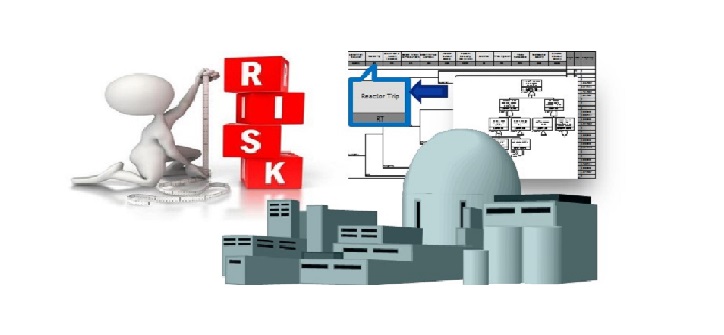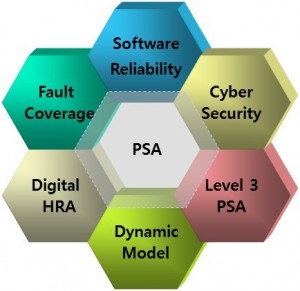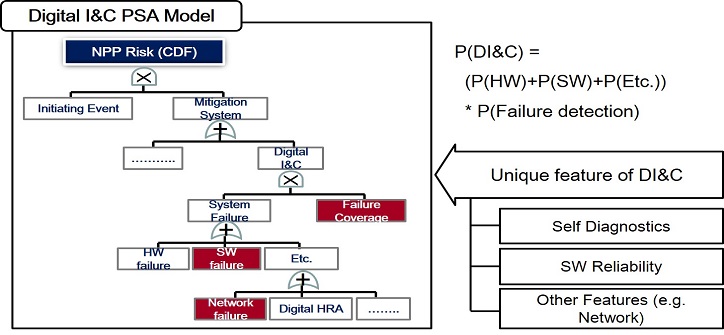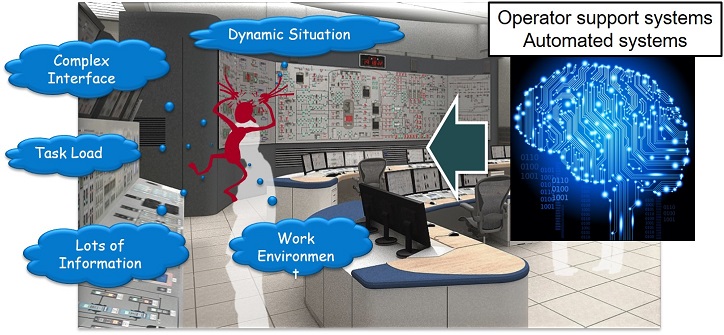
A nuclear power plant is one of the most safety-critical infrastructures. The reliability or risk evaluation of nuclear power plants is crucial in plant designing, licensing, and various decision makings.
Probabilistic Safety Assessment (PSA) or Probabilistic Risk Assessment (PRA) is to estimate risk by computing real numbers to determine what can go wrong, how likely is it, and what are its consequences. Thus, PSA provides insights into the strengths and weaknesses of the design and operation of a nuclear power plant. PSA can estimate three levels of risk.
- Level 1 PSAestimates the frequency of accidents that cause damage to the nuclear reactor core. This is commonly called core damage frequency (CDF).
- Level 2 PSA, which starts with the Level 1 core damage accidents, estimates the frequency of accidents that release radioactivity from the nuclear power plant.
- Level 3 PSA, which starts with the Level 2 radioactivity release accidents, estimates the consequences in terms of injury to the public and damage to the environment.
The major research of this lab has been focused on the enhancement of risk assessment quality by resolving the emerging issues, and risk-informed applications such as the improvement of plant designing based on the risk assessment results. Followings are the research topics of this lab.
- Reliability evaluation of digital I&C systems in nuclear power plants
- Human reliability evaluation for digitalized operational environments
- Cyber security evaluation of digitalized nuclear power plants
- Level 3 PSA for nuclear facilities
- Dynamic PSA modelling

Reliability Evaluation of Digital I&C Systems in Nuclear Power Plants

For the last couple of decades, analog intrumentation and control (I&C) systems have been replacing with digital I&C systems. Digital systems have their unique features such as software, network, self-diagnostics, and so on. The effects of these distinguishable features from analog systems should be reflected on the safety assessment for digitalized nuclear power plants. Currently, we are performing the following researches:
- Reliability evaluation of safety-critical software
- Fault coverage evaluation of self-diagnostics
- Identification of vulnerabilities against cyber attacks.
Based on above risk assessment results, it is possible to propose more reliable and safer system designs by improving software reliabilty and fault coverage and eliminating vulnerabilities by cyber attacks.
Human Reliability Analysis and Operator Support System Development

Human reliability evaluation is a very important part in nuclear power plant safety assessment. The operations of main control room operators are highly complex and mentally taxing activities. In fact, more than 50% of nuclear power plants accidents have been caused by human errors. However, there is quite large uncertainty in human reliability analysis because it is not easy to understand the congnitive process inside human operators and to quantify human error probabilities. Moreover, recently developed digitalized operational environment might change the human error probabilities and possible human error modes. This research is focused on the development of human reliability analysis method for the digitalized operational environment and operator support systems to prevent human errors.
Level 3 PRA for Consequence Analysis

After the Fukushima accident, the level 3 PSA has introduced as one of the most significant issues for a safety assessment. Atmopheric dispersion prediction is a key in the level 3 PSA to predict radiation releases into the environment for preparing an effective strategy for an evacuation as a basis of the emergency preparedness. To predict the atmospheric dispersion accurately, the specific conditions of the radiation release location should be considered. Currently, there is no level 3 PSA method which can consider the characteristics of environmental conditions in Korea. Since all Korean nuclear sites are located on coasts, sea and land breezes might be a significant factor. This research is to solve the technical issues for Korea level 3 PSA.
